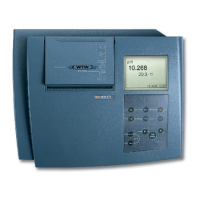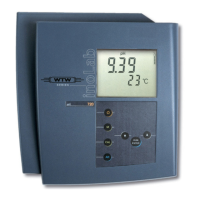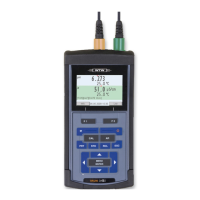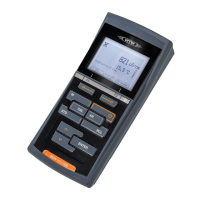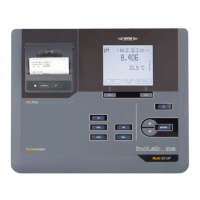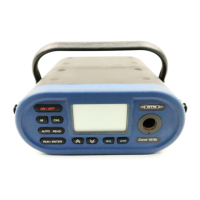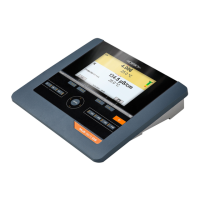
Do you have a question about the wtw inoLab Multi 9620 IDS and is the answer not in the manual?
| Brand | wtw |
|---|---|
| Model | inoLab Multi 9620 IDS |
| Category | Measuring Instruments |
| Language | English |
Introduction to the Multi 9620 IDS meter.
Information about the sensor types supported by the meter.
Details on Intelligent Digital Sensors (IDS) and their features.
How to connect IDS sensors wirelessly using adapters.
Using adapters to connect analog sensors to the meter.
How the meter automatically identifies connected IDS sensors.
General safety guidelines and important information for safe operation.
Guidelines and requirements for operating the meter safely.
Defines the intended and approved uses of the meter.
Specifies conditions and practices necessary for safe meter operation.
Outlines conditions under which the meter must not be operated.
Lists all items included in the package with the meter.
Details on how the meter receives its power supply.
Step-by-step guide for the initial setup and startup of the meter.
Instructions for connecting the meter's power supply unit.
Basic principles for interacting with and operating the meter.
Explanation of the meter's keypad layout and functions.
Description of the meter's display interface and elements.
Understanding the status indicators and messages displayed by the meter.
Identification and description of the meter's various connection ports.
Visual representation of sensor connections and parameter assignments.
Accessing and viewing detailed information about connected sensors.
How to view measurements from multiple connected sensors simultaneously.
Procedure for powering on the meter and initial self-test.
Procedure for safely powering down the meter.
How to log in using user credentials for access control.
How to navigate through the meter's menus and settings.
Explanation of the different operational states of the meter.
How measured values are presented on the display.
Understanding the structure and interaction within menus and dialog boxes.
A practical example demonstrating language setting navigation.
A practical example demonstrating date and time setting navigation.
Procedures for performing pH measurements with the meter.
Detailed steps for accurately measuring pH using an IDS sensor.
Procedures for calibrating pH sensors to ensure measurement accuracy.
Reasons why pH electrode calibration is essential for accurate readings.
Guidelines on the frequency and conditions requiring pH calibration.
Step-by-step guide for performing automatic pH calibration.
Step-by-step guide for performing manual pH calibration.
Details on selecting and using calibration buffer points.
How to view and interpret stored pH calibration records.
Explanation of the CMC function for real-time measurement monitoring.
Details on the Quality Sensor Control (QSC) feature for sensor performance.
Procedures for performing ORP (Oxidation-Reduction Potential) measurements.
Detailed steps for measuring ORP with an IDS sensor.
How to measure the relative ORP difference between solutions.
Importance and method of measuring temperature during ORP measurements.
Information on checking ORP sensor performance using test solutions.
Procedures for measuring ion concentrations using ISE sensors.
Detailed steps for measuring ion concentration with ISE electrodes.
Procedures for calibrating ISE sensors for accurate ion measurements.
Reasons for calibrating ion-selective electrodes for accurate readings.
Guidelines on when ISE sensor calibration is necessary.
Step-by-step guide for performing ISE calibration.
Information on selecting and using standard solutions for ISE calibration.
How to view and interpret stored ISE calibration records.
Overview of supported methods for ion concentration measurement.
Procedures for measuring dissolved oxygen (D.O.) levels.
Detailed steps for measuring dissolved oxygen using an IDS-D.O. sensor.
Procedure for checking the performance of the FDO® 925 D.O. sensor.
Reasons for performing an FDO® Check on the D.O. sensor.
Conditions and circumstances that warrant an FDO® Check.
Step-by-step guide on how to conduct an FDO® Check.
How to interpret the results of an FDO® Check.
Procedures for calibrating D.O. sensors.
Reasons why D.O. sensor calibration is necessary.
Guidelines on when D.O. sensor calibration should be performed.
Overview of the available calibration methods for D.O. sensors.
Step-by-step guide for D.O. calibration using saturated air.
Guide for D.O. calibration using a comparison measurement.
How to view and interpret stored D.O. calibration records.
Procedures for measuring conductivity using IDS sensors.
Detailed steps for measuring conductivity with an IDS sensor.
Importance and method of measuring temperature for conductivity measurements.
Explanation of temperature compensation methods for conductivity.
Procedures for calibrating conductivity sensors.
Reasons why conductivity sensor calibration is necessary.
Guidelines on when conductivity sensor calibration should be performed.
How to determine the cell constant for conductivity sensors.
How to view and interpret stored conductivity calibration records.
Procedures for measuring turbidity with the VisoTurb® 900-P sensor.
Detailed steps for performing turbidity measurements.
Procedures for calibrating the turbidity sensor.
Reasons why turbidity sensor calibration is necessary.
Guidelines on when turbidity sensor calibration should be performed.
Information on selecting and using standard solutions for turbidity calibration.
Step-by-step guide on how to perform turbidity calibration.
How to view and interpret stored turbidity calibration records.
Configuration options for pH measurements.
Specific configuration settings related to pH measurements.
List of available buffer sets for pH calibration.
Setting the reminder interval for pH sensor calibration.
Configuration options for ORP measurements.
Configuration options for ISE measurements.
Configuration options for Dissolved Oxygen measurements.
Specific configuration settings related to D.O. measurements.
Configuration options for conductivity measurements.
Specific settings for IDS conductivity sensors.
Configuration options for turbidity measurements.
Specific settings for turbidity sensors.
Settings that apply regardless of the connected sensor.
General system settings like language, audio, and brightness.
Settings related to storing and managing measurement data.
Configuration for the automatic stability control feature.
Procedures for resetting meter settings to default values.
How to reset measurement-specific settings.
How to reset general system settings.
How to manually save measurement datasets.
How to configure automatic saving of data at set intervals.
Managing stored measurement data, including viewing and editing.
Options for viewing, outputting, or erasing stored measurement data.
Procedure for clearing stored measurement data.
Components that make up a complete measurement dataset.
Information on the meter's data storage capacity and types.
How to transfer data to a USB storage device.
How to print measurement data directly to a USB printer.
Steps for transferring data from the meter to a personal computer.
Using the MultiLab Importer software for data recording and evaluation.
General maintenance tasks for the meter.
Overview of routine maintenance procedures.
Instructions for replacing the meter's system clock battery.
Guidelines for cleaning the exterior of the meter.
Recommendations for packing the meter for transport.
Information on proper disposal procedures for the meter at its end of life.
Troubleshooting common issues encountered during pH measurements.
Troubleshooting common issues encountered during ISE measurements.
Troubleshooting common issues encountered during dissolved oxygen measurements.
Troubleshooting common issues encountered during conductivity measurements.
Troubleshooting common issues encountered during turbidity measurements.
Troubleshooting for general meter issues and common problems.
Key technical specifications including measurement ranges and accuracy.
General technical specifications such as dimensions, weight, and operating conditions.
Instructions for updating the meter's firmware.
Instructions for updating the firmware of connected IDS sensors.
